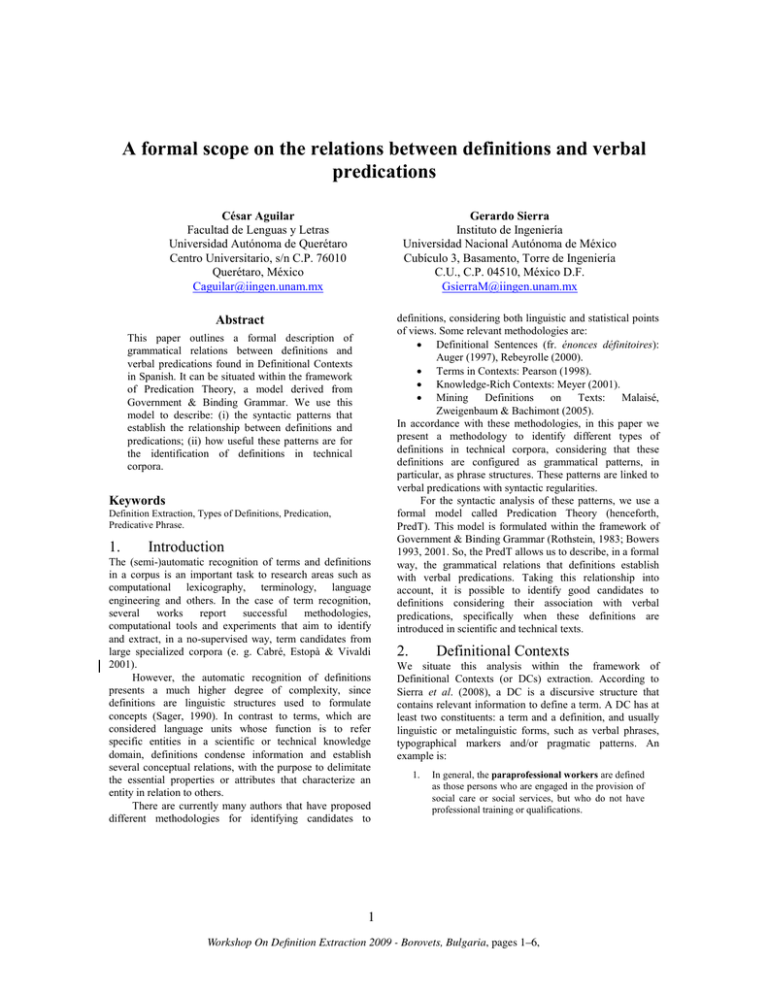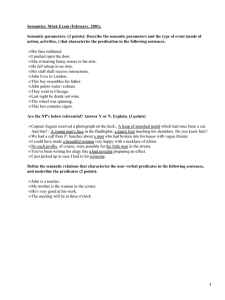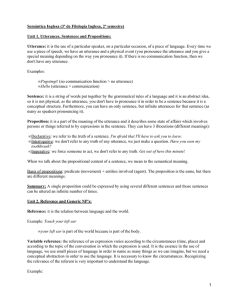A Formal Scope on the Relations Between Definitions and Verbal
Anuncio

A formal scope on the relations between definitions and verbal predications César Aguilar Facultad de Lenguas y Letras Universidad Autónoma de Querétaro Centro Universitario, s/n C.P. 76010 Querétaro, México [email protected] Gerardo Sierra Instituto de Ingeniería Universidad Nacional Autónoma de México Cubículo 3, Basamento, Torre de Ingeniería C.U., C.P. 04510, México D.F. [email protected] Abstract This paper outlines a formal description of grammatical relations between definitions and verbal predications found in Definitional Contexts in Spanish. It can be situated within the framework of Predication Theory, a model derived from Government & Binding Grammar. We use this model to describe: (i) the syntactic patterns that establish the relationship between definitions and predications; (ii) how useful these patterns are for the identification of definitions in technical corpora. Keywords Definition Extraction, Types of Definitions, Predication, Predicative Phrase. 1. Introduction The (semi-)automatic recognition of terms and definitions in a corpus is an important task to research areas such as computational lexicography, terminology, language engineering and others. In the case of term recognition, several works report successful methodologies, computational tools and experiments that aim to identify and extract, in a no-supervised way, term candidates from large specialized corpora (e. g. Cabré, Estopà & Vivaldi 2001). However, the automatic recognition of definitions presents a much higher degree of complexity, since definitions are linguistic structures used to formulate concepts (Sager, 1990). In contrast to terms, which are considered language units whose function is to refer specific entities in a scientific or technical knowledge domain, definitions condense information and establish several conceptual relations, with the purpose to delimitate the essential properties or attributes that characterize an entity in relation to others. There are currently many authors that have proposed different methodologies for identifying candidates to definitions, considering both linguistic and statistical points of views. Some relevant methodologies are: Definitional Sentences (fr. énonces définitoires): Auger (1997), Rebeyrolle (2000). Terms in Contexts: Pearson (1998). Knowledge-Rich Contexts: Meyer (2001). Mining Definitions on Texts: Malaisé, Zweigenbaum & Bachimont (2005). In accordance with these methodologies, in this paper we present a methodology to identify different types of definitions in technical corpora, considering that these definitions are configured as grammatical patterns, in particular, as phrase structures. These patterns are linked to verbal predications with syntactic regularities. For the syntactic analysis of these patterns, we use a formal model called Predication Theory (henceforth, PredT). This model is formulated within the framework of Government & Binding Grammar (Rothstein, 1983; Bowers 1993, 2001. So, the PredT allows us to describe, in a formal way, the grammatical relations that definitions establish with verbal predications. Taking this relationship into account, it is possible to identify good candidates to definitions considering their association with verbal predications, specifically when these definitions are introduced in scientific and technical texts. 2. Definitional Contexts We situate this analysis within the framework of Definitional Contexts (or DCs) extraction. According to Sierra et al. (2008), a DC is a discursive structure that contains relevant information to define a term. A DC has at least two constituents: a term and a definition, and usually linguistic or metalinguistic forms, such as verbal phrases, typographical markers and/or pragmatic patterns. An example is: 1. In general, the paraprofessional workers are defined as those persons who are engaged in the provision of social care or social services, but who do not have professional training or qualifications. 1 Workshop On Definition Extraction 2009 - Borovets, Bulgaria, pages 1–6, According to this example, the term Paraprofessional workers is emphasised by the use of bold font; the verbal predication are defined as links the term paraprofessional workers to the actual definition those persons who are engaged... The term, the verbal predication and the definition are discursive units introduced by the pragmatic pattern In general. These are the three units that constitute the main syntactic sequence of a DC. In this work we study this kind of DCs in Spanish, where the association between definitions and verbal predications is made explicit. Figure 1: Tree representation for PrP, according to Bowers (1993: 596). 3. A formal description respect to predication Taking into consideration that these sequences are composed of a verbal predication and definitions, several authors have found and reported such sequences for English (Pearson, 1998; Meyer 2001; Malaisé, Zweigenbaum & Bachimont, 2005) and French (Auger 1997, Rebeyrolle 2000). These authors have considered the use of these types of verbal predications as useful patterns for the (semi)automatic extraction of information associated to definitions. However, none of these authors have analysed the nature of the relations between predications and definitions. In this paper, we focus on the description of their nature at the syntactic level, based on the PredT as a pertinent formal model for explaining the relations established between verbal predications and definitions. 3.1 Figure 1 shows the basic elements that make up a PrP. Bowers recognise a functional head with the features +/predicative (Pr). This head maps two Subjects, a primary subject in the position of Specifier of PrP (represented by a Noun Phrase or NP); and a secondary subject, in the position of Specifier of Verbal Phrase or VP (often a NP). Finally, both subjects, the VP and the PrP are linked to one or several complements, which assume many phrasal representations (e.g. NP, IP, CP, and so on). 3.2 Primary and secondary predications Based on this distinction between primary and secondary subjects, it is possible to recognise two types of predications: Predication theory in GB grammar Grosso modo, PredT is a model derived from Government & Binding Grammar, formulated by Chomsky (1981). PredT postulates that all predications indicate a semantic relationship between an entity and a particular property or characteristic feature. Syntactically, PredT explains all verbal predications as a type of phrase, structured around a relation X-is-a-Subject-of/Y-is-a-predicate-of. This relation is regulated by a syntactic rule named rule of predicate linking, proposed by Rothstein (1983). Examples of these relations are: 2. a. John is an intelligent professor. b. John considers his father as an intelligent professor. Following Rothstein’s explanation, Bowers (1993, 2001) develops a simple model to describe the syntactic configuration of these phrases, called Predicative Phrase (PrP). The PrP is mapped by a non-lexical head (that is, a functional head), and its grammatical behaviour is similar to that of phrases such as Inflexional Phrase (IP) or Complement Phrase (CP). A graphical tree representation of a PrP is: 2 Simple or primary predication, consisting of a subject to the left of the verb (in position of Specifier of PrP), and a predicate to the right of the verb. An example in Spanish is: 3. [Una computadora [es [un tipo de máquina electrónica que sirve para hacer operaciones PrP] VP] IP] (Eng. [A computer [is [a kind of electronic machine used to make operations PrP] VP] IP]). Double or secondary predication, which integrates a primary subject in a pre-verbal position, a secondary subject (situated as Specifier of VP), and the predicate. For example, again, in Spanish: 4. [Turing [define una computadora [como un mecanismo electrónico que procesa conjuntos de datos PrP] VP] IP] (Eng. [Turing [defines a computer [as a kind of electronic device that processes a set of data PrP] VP] IP]). In (4), the predicate como un mecanismo electrónico... (Engl. as a kind of electronic device...) affects the secondary subject una computadora (Engl. a computer), in accordance with the explanation provided by Bowers (1993). For our analysis, we consider both types of predications as regular patterns that syntactically codify sequences of terms, verbal predications and definitions. 4. b. [El artículo Author] [describe Verbal Predication] [la evolución de ecología del paisaje Term] [como una ciencia integrativa y transdisciplinaria Definition] (Eng. [The article Author] [describes Verbal Predication] [the evolution of landscape ecology Term] [as an integrative and interdisciplinary science Definition]). c. [Ø Podemos Author] [considerar Verbal Predication] [las computadoras programables modernas Term] [como la evolución de sistemas antiguos de cálculo o de ordenación Definition] (Eng. [We Author] [can consider Verbal Predication] [the modern programmable computers Term] [as the evolution of ancient systems of calculation and management Definition]). Combinatory of patterns in DCs Based on our formal description of PrP, it is possible to identify two types of patterns that structure particular sequences in DCs: 4.1. In the case of primary predications, it codifies a sequence composed of a Term, a Verbal Predication and a Definition. In the case of secondary predication, it codifies a sequence composed of a specific Author, a Term, a Verbal Predication and a Definition. Term + Verbal Predication + Definition This sequence is a good example of a formulation of canonical definitional patterns, because the primary predication links directly a subject represented by a term, with a specific set of attributes codified in the PrP. These patterns are shown in the following sequences: 5. a. [El contenedor refrigerado Term] [es Verbal Predication] [una forma especializada de transporte de perecederos Definition] (Eng. [The refrigerated container Term] [is Verbal Predication] [a specialized form to transport perishable goods Definition]) b. [Un esquema XML Term] [representa Verbal Predication] [el significado y la estructura de la información recibida desde una aplicación Definition] (Eng. [An XML schema Term] [represents Verbal Predication] [the meaning and structure of the information received from an application Definition]). c. [Una jerarquía de dependencias Term] [se refiere a Verbal Predication] [todas las tablas que incluyen referencias mutuas Definition] (Eng. [A hierarchy of units Term] [refers to Term] [all tables that include references to each other Definition]). The sequence Term + Verbal Predication + Definition in cases 5 a-c is equivalent to the structure of primary predication. Therefore, the Term is situated in the position of Primary Subject, the Verbal Predication has the role of head of a VP, and the Definition is introduced through a PrP. Hence, the pattern followed by this sequence clearly refers to the author of a definition, as shown in 6 a-c. However, a syntactic behaviour observed in this pattern is its recurrent configuration in non-personal forms, i.e. impersonal and passive forms, for example: 7. a. [Se conoce como Verbal Predication] [reenganche rápido Term] [a la operación de cierre de un interruptor después de una falla Definition] (Eng. [It is known as Verbal Predication] [Quick Re-closing Term] [to the operation of a switch after a fault Definition]). b. [Los niveles relativos de los alcances de ola Term] [fueron descritos como Verbal Predication] [una función del parámetro de similitud de oleaje Definition] (Eng. [The relative levels of the wave reach Term] [were described as Verbal Predication] [a function of the wave similarity parameter Definition] In these examples, we observe the use of non-personal verbal patterns as in (7a), where the clitic Se is inserted (Eng. It) to make the sentence impersonal, or in (7b), which is in the passive form. So, when these sequences assume a non-personal pattern, they become equivalent to primary predications, where there is not an explicit mention of the author of a definition. 5. 4.2. Author + Term + Verbal Predication + Definition The second sequence we report here shows the sequence Author + Term + Verbal Predication + Definition. The characteristic feature of this pattern is that it explicitly points out the author (or authors) of the definition. This feature maps a semantic role, according to FrameNet (Baker, Fillmore and Lowe, 1998), concretely the author can be conceived as a Cognizer that associates certain Categories (the Definition) to a particular Item (that is, the Term). This is illustrated in the following examples: 6. a. [Carlos Godino Author] [define Verbal Predication] [la arquitectura naval Term] [como la ciencia que se enfoca en la construcción de los buques Definition] (Eng. [Carlos Godino Author] [defines Verbal Predication] [naval architecture Term] [as the science that focuses on the construction of ships Definition]) Types of definitions linked to predications Another aspect that we found in the relation between predications and definitions is the influence of the predication on the selection of a particular type of definition. In fact, this influence is important because we can establish and formalise a possible grammar model that helps to identify different kinds of definitions, given a primary or secondary predication. Following Sierra et al. (2008) and Aguilar (2009), we outline a typology with 4 types of definitions: analytical, synonymical, functional and extensional. These definitions are derived from Aristotle’s model: Genus Term Synonymical 3 Differentia Functional Extensional Figure 2. Typology of definitions based on Aristotle’s model (Sierra et al. 2008: 81). Figure 2 illustrates how these four types of definitions can be identified according to the presence/absence of Genus Term and/or Differentia in a good candidate of definition. So, when both the Genus Term and the Differentia are explicit, we have an analytical definition, which can be associated with two kinds of predication: primary predication or secondary predication. When only the Genus Term is explicit, there is a certain relation of conceptual equivalence between the term and its definition. So, following Cruse (1986), we characterise this definition as synonymical. In contrast, when only the Differentia is explicit, we have two options: The first one describes the use or the function of an entity represented by the term, that is, a functional definition. The second one enumerates all the components of a possible entity or a possible set, that is, an extensional definition. In the following sections we briefly describe each type of definition. 5.1. Definition Analytical (Secondary Predication) [El apartarrayos Term] [es Verbal Predication] [un dispositivo [que protege las instalaciones contra Genus Term] sobretensiones de origen atmosférico Differentia] (Engl. [The lightning conductor Term] [is Verbal Predication] [a device Genus Term] [that protects electrical systems against surges of atmospheric origin Differentia]). Analytical (Simple Predication) Genus Term Noun Phrase = Noun + {Adjective Phrase/Prepositional Phrase}* Genus Term Differentia Noun Phrase = Noun + {Adjective Phrase/Prepositiona l Phrase}* Complement Phrase = Relative Pronoun + Inflexional Phrase Prepositional Phrase = Preposition + Noun Phrase Adjective Phrase = Adjective + Noun Phrase 5.2. Synonymous definitions The synonymous definitions have a syntactic relation with primary predications, specifically with the Genus Term, but not with the differentia. An example is: 9. [La tensión de base Term] [se le llama también Verbal Predication] [tensión unidad Genus Term]. (Engl. [The base tension¨ Term] [it is also called Verbal Predication] [unit tension Genus Term]). In (9), we observe that the Term la tensión de base (Engl. the base tension) establishes a relation of cognitive equivalent with the Genus Term tensión unidad (Engl. unit tension). We formalise this relation in table 3: Definition Term Genus Term Synonymical Noun Phrase = Noun + Noun Phrase = Noun + (Primary {Adjective {Adjective Predication) Phrase/Prepositional Phrase/Prepositional Phrase}* Phrase}* We propose a possible grammatical description model for this relation: Definition Adverb/ Preposition Como Por Table 2. Construction patterns derived from the relation between secondary predication and analytical definition Analytical definitions This definition occurs associated with primary and secondary predications. In the case of primary predication, the analytical definition is integrated in a sequence Term + Verbal Predication + Definition. This definition does not explicitly state the author of a definition. For example: 8. In the case of secondary predications linked to analytical definitions, they follow the sequence Author + Term + Verbal Predication + Definition, where the Author is equivalent to the primary subject, the Term assumes the position of secondary subject, and the definition is introduced after the Verbal Predication. In this case, the adverbial particle como (Eng. as/like), or the preposition por (Eng. for/by) indicate the place of the definition: Table 3. Construction patterns derived from the relation between primary predication and synonymous definition 5.3. Differentia Complement Phrase = Relative Pronoun + Inflexional Phrase Prepositional Phrase = Preposition + Noun Phrase Adjective Phrase = Adjective + Noun Phrase Table 1. Construction patterns derived from the relation between primary predication and analytical definition 4 Functional definitions The functional verbal pattern introduces a type of definition where the Genus Term is absent, but introduces a Differentia that describes the function or the use of a particular entity. The verbal pattern is also associated with a primary predication. The example is: 10. [La técnica de velocimetría de imágenes Term] [permite Verbal Predication] [medir la velocidad de un campo de flujo bi o tri dimensional Differentia] (Engl. [The method of image velocimetry Term] [allows Verbal Predication] [to measure the speed of a flow field in two or three dimensions Differentia]). The formal description of this relation between predication and definition is: Definition Differentia Functional (Primary Predication) Infinitive Verb + Complement Phrase = Relative Pronoun + Inflexional Phrase + {Prepositional Phrase/Adjetive Phrase/Adverbial Phrase/Complement Phrase}* Definition Analytical (Primary Predication) Verbs referir (to refer to) representar (to represent) ser (to be) significar (to signify/to mean) Analytical (Secondary Predication) caracterizar (to characterise) comprender (to include) concebir (to conceive) conocer (to know) considerar (to consider) definir (to define) describir (to describe) entender (to understand) identificar (to identify) visualizar (to visualise) equivaler (to be equivalent to) llamar (to call) nombrar (to name) ser _ igual (to be equal to) ser _ similar (to be similar to) Infinitive Verb + Preposition + {Inflexional Phrase/Complement Phrase}* Prepositional Phrase = Preposición + Noun Phrase + {Prepositional Phrase/Adjetive Phrase/Adverbial Phrase/Complement Phrase}* Noun Phrase = Noun + {Prepositional Phrase/Adjetive Phrase/Adverbial Phrase/Complement Phrase}* Synonymy Table 4. Construction patterns derived from the relation between primary predication and functional definition 5.4. Extensional definitions Finally, extensional definitions provide a complete list of the parts,,components or elements of a entity or set. In a similar way to functional definitions, extensional definitions are structured around a primary predication. An example is: 11. [La zona límite Term] [incluye Verbal Predication] [planicies costeras, marismas, áreas de inundación, playas, dunas y corales Differentia] (Eng. [The border zone Term] [includes Verbal Predication][coastal plains, salt marshes, flood areas, beaches, dunes and corals Differentia]). Functional (Primary Predication) Extensional (Primary Predication) Our syntactic description of this pattern is: Definition Extensional (Primary Predication) Preposition Con (Eng With) De (Eng. Of) Differentia Noun Phrase = Noun + {Adjective Phrase/Prepositional Phrase}* Associated Particles a = to (preposition) (in the case of referir, it is a phrasal verb that inserts obligatory the preposition a) como = as/like (adverb) por = for/by (preposition) también = also (adverb) a = to (preposition) igual a = equal to (adverb phrase) similar a = similar to (adverb phrase) emplearse (to employ + clicit de = of (preposition) “se”) para = for (preposition) encargar (to be in charge of) funcionar (to function) ocupar (to occupy) permitir (to allow) servir (to serve) usar (to use) utilizar (to utilise / to use) componer (to be composed of) de = of (preposition) comprender (to include) por = for/by (preposition) consistir (to consist of) con = with (preposition) constar (to consist of) contar (to have) constituir (to constitute) contener (to contain) incluir (to include) integrar (to integrate) Table 6. Verbs associated with definitions 6. Commentaries and conclusions Table 5. Construction patterns derived from the relation between primary predication and extensional definition We can summarise all these patterns in table 6, considering some recurrent verbs in the position of head of PrP. These verbs are not exclusive, but their recurrence has been reported by Sierra et al. (2008), and Aguilar (2009): In this paper, we have outlined a formal description of the grammatical relations that can be established between definitions and verbal predications in DCs. We consider this is a pertinent way to analyse the syntactic behaviour of definitions in specialised texts, specifically when these definitions are linked to verbal predications. We have described these verbal predications according to the PredT, a grammatical model useful to formalise patterns generated by the association of verbal predications to specific definitions. This description allowed us to distinguish: 5 Two types of verbal predications: primary and secondary predications. Both predications entail particular types of definitions, depending on the verb that functions as the head of the predication. These predications play an important role in the selection and introduction of specific types of definitions. In this paper, we have proposed a possible typology of definitions, based on the role played by predications. This typology considers four types of definitions: analytical, synonymical, functional and extensional. [8] D. Cruse. Lexical Semantics. Cambridge, Cambridge University Press, 1986. [9] V. Malaisé, P. Zweigenbaum & B. Bachimont. Mining defining contexts to help structuring differential ontologies. Terminology 11(1): 21-53, 2005. In addition, it is possible to observe that the relation established between the types of definitions with primary/secondary predications configure two sequences that structure two different kinds of DCs: (i) a sequence, Term + Verbal Predication + Definition, configured in primary predications which can be linked to analytical, synonymical, functional and extensional definitions and; (ii) another sequence, Author + Term + Verbal Predication + Definition, delineated by secondary predications which can be associated to secondary predications. [10] I. Meyer. Extracting knowledge-rich contexts for terminography: A conceptual and methodological framework. In Bourigault D., C. Jaquemin & M.C. L’Homme (eds.). Recent Advances in Computational Terminology, Amsterdam/Philadelphia, John Benjamins: 279-302, 2001. We think that the use of these patterns proposed in our analysis can sketch a useful grammatical model, applied to the task of (semi)automatic recognition and extraction of definitions in Spanish, from text corpora. 7. Acknowledgements This paper was made possible by the financial support of the Consejo Nacional de Ciencia y Tecnología, CONACYT, and DGAPA-UNAM. 8. References [1] C. Aguilar. Análisis lingüístico de definiciones en contextos definitorios. Ph. D. Thesis, National Autonomous University of Mexico, Mexico City, 2009. [2] A. Auger. Repérage des énonces d’intérêt définitoire dans les bases de données textuelles. Thèse de Doctorat, Neuchâtel, Université de Neuchâtel, 1997. [3] C. Baker, Ch. Fillmore, & J. Lowe. The Berkeley FrameNet Project. In Proceedings of the COLING-ACL, Montreal, Canada, 1998. [4] J. Bowers. The Syntax of Predication. Linguistic Inquiry, 24(4): 591-636, 1993. [5] J. Bowers. Predication. In Baltin, M. & C. Collins (eds.). The Handbook of Contemporary Syntactic Theory. Oxford, Blackwell: 299-333, 2001. [6] T. Cabré, R. Estopà & J. Vivaldi. Automatic term detection. In Bourigault D., C. Jaquemin & M.C. L’Homme (eds.). Recent Advances in Computational Terminology. Amsterdam/Philadelphia, John Benjamins: 53-87, 2001. [7] N. Chomsky. Lectures on Government and Binding. The Hague, Mouton de Gruyter, 1981. 6 [11] J. Pearson. Terms in Contexts. Amsterdam/Philadelphia, John Benjamins, 1998. [12] J. Rebeyrolle. Forme et fonction de la définition en discours, Thèse de Doctorat. Toulouse, Université Toulouse-Le Mirail, 2000. [13] S. Rothstein. The Syntax Forms of Predication, Ph. D. Thesis. Cambridge, Mass., MIT, 1983. [14] J.C. Sager. Essays on Definitions, Amsterdam/Philadelphia, John Benjamins., 1990. [15] G.Sierra, R. Alarcon, C. Aguilar & C. Bach. Definitional Verbal Patterns for Semantic Relation Extraction. In Auger A. y C. Barrière (eds.). Pattern-based Approaches to Semantic Relation Extraction. Special issue of Terminology, 14(1): 74–98, 2008.


